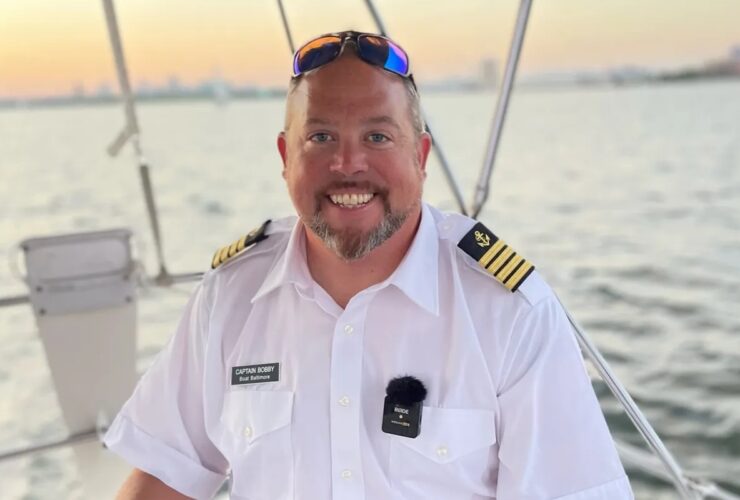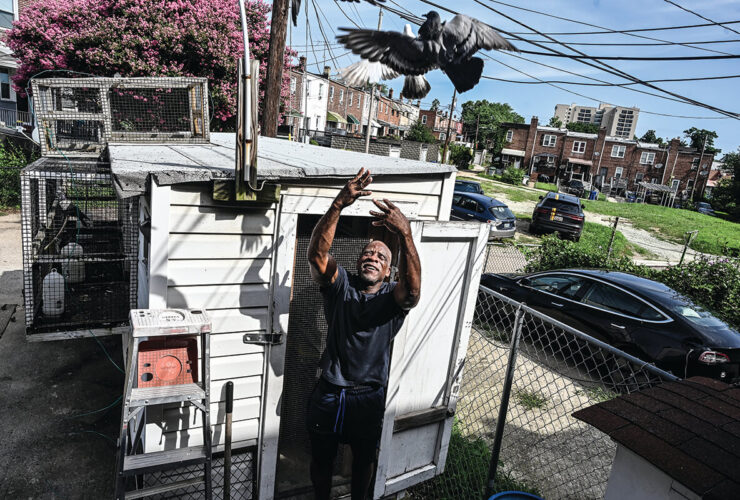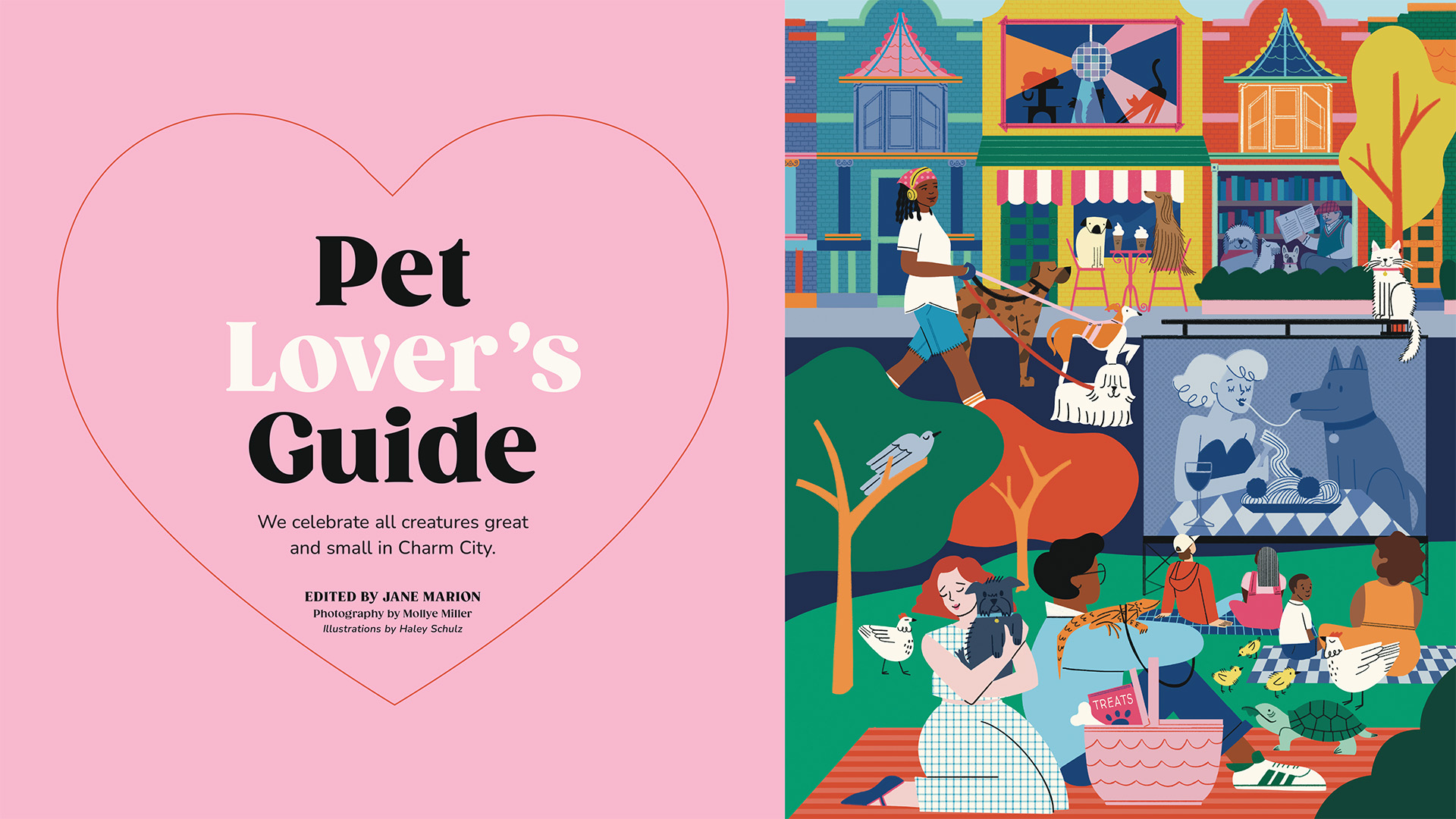
Home & Living
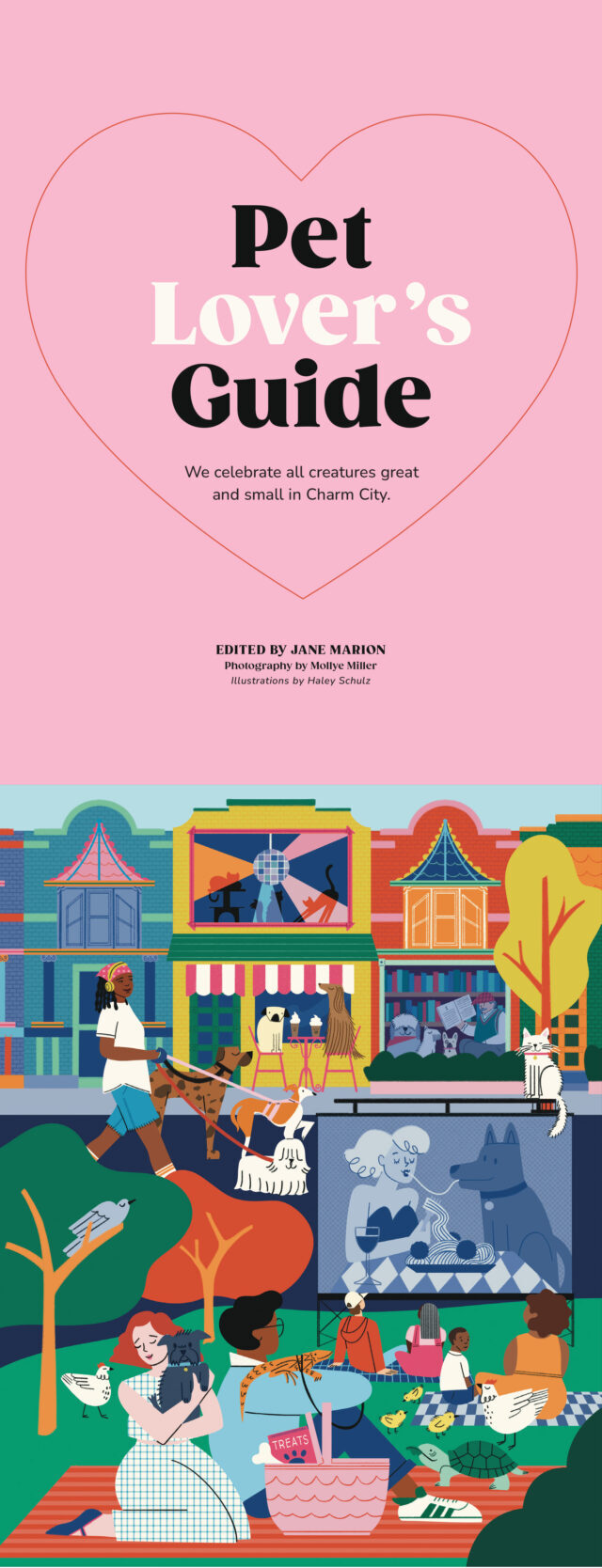

WHY DO WE LOVE OUR PETS? Is it because they offer the purest form of unconditional love, making us feel valued, adored, and special? Is it because they’re good for our health? (Studies show that pets can reduce stress, anxiety, and depression, as well as ease loneliness, encourage exercise, and improve overall health.) Or is it because our hearts melt when our cats purr or our dogs look at us with those patented puppy-dog eyes and go wild with excitement when we come home, even if we’ve only just left to get mail at the end of the driveway? Of course, it’s all the above and more.
True love doesn’t always make a lick of sense—having a pet is a real commitment of time, money, and learning to let go (forget about those rugs and upholstered sofas), not to mention a total test of patience, as anyone with a puppy (or elderly animal) can attest. And yet most pet owners do it again—and again—when their pet passes.
More and more Americans are relishing the joys of adding a pet to the family tree. According to the American Veterinary Medical Association, the number of pet-owning households with dogs increased from 31.3 million in 1996 to 59.8 million in 2024, while cat-owning households went from 27 million to 42.1 million in that same timeframe. And during the COVID-19 pandemic, pet ownership exploded, with one in five households acquiring a pet. (A survey by the ASPCA reveals that approximately 23 million American households added a new cat or dog during the crisis.) In other words, pets are becoming an increasingly integral part of our lives.
Our Pet Lover’s Guide is a celebration of all creatures great and small, present and past, of those we loved and those we’re still loving. In the feature that follows, we share which area restaurants welcome four-legged friends, we marvel at the amazing abilities of service dogs, and we share a few of our staffers’ stories about the furry (or feathered) loved ones in their lives.
And while Baltimore isn’t exactly Paris, where pets are welcomed almost anywhere humans go, Charm City offers plenty of places to enjoy time with your pet outside your home. If you’re an avowed pet lover, new to pet ownership, or contemplating adopting a cat or dog, or buying a bird, pig, or snake, we hope our story inspires you.

Service dogs work their tails off for their human handlers.
By Jane Marion
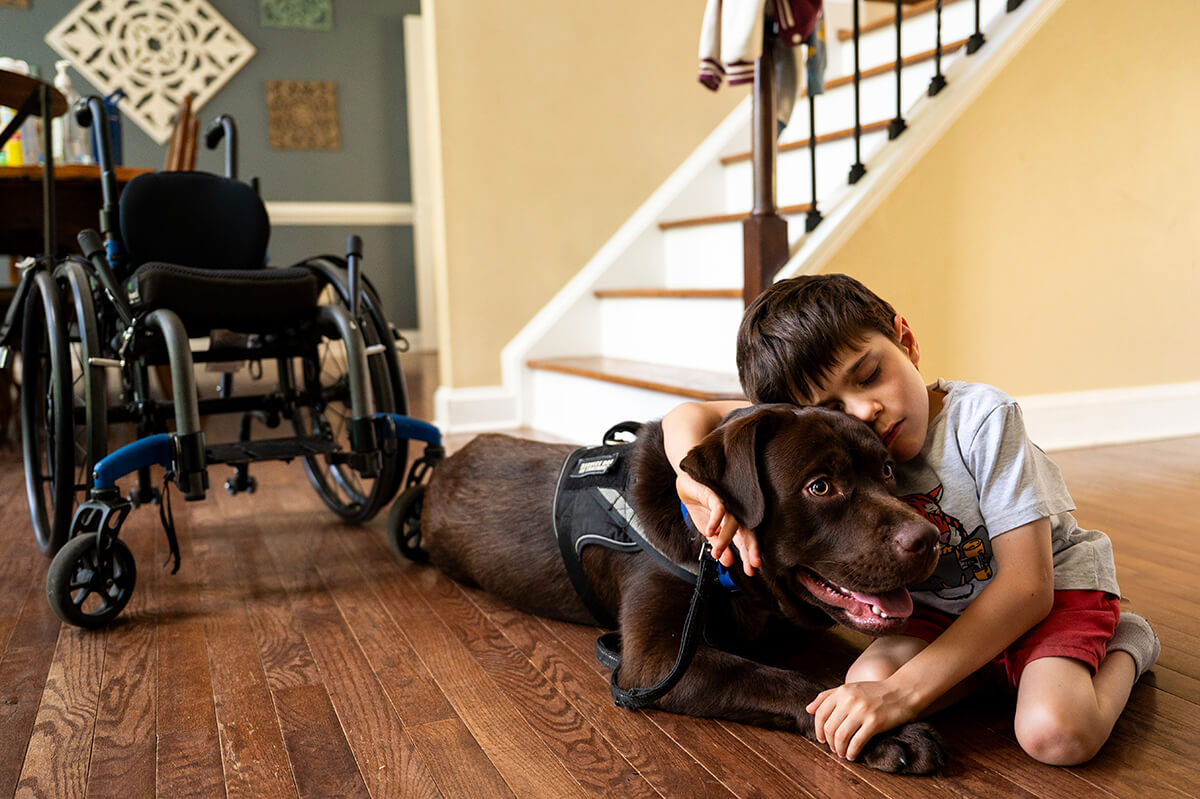

n the Greenspring Campus of Kennedy Krieger High School in Baltimore, Rocket stretches across the wood floor of the gym snoring, just like any other dog sacked out after a long car ride and a full morning of activity.
But on this June day, Rocket has had a busier morning than most of his puppy peers. After all, he serves as the sidekick, official fetcher, and rightpaw man to his best friend, Ari Jarrett, a spirited 8-year-old, wheelchair-bound boy who, on this day sunny Saturday afternoon, is engaged in his usual round of recreational activities. Today that means swimming and basketball. For Rocket, there have been ongoing reminders to walk parallel to the wheelchair, dropped swim googles to fetch and return, plus emotional support for Ari, who, understandably, has a fear of sinking when he swims.
Ari was born with a rare defect to his skeletal system, resulting in the pinching of his spinal cord before birth. “He is totally unable to walk or stand and has a host of other medical issues,” explains his mom, Brianna Jarrett. “Otherwise, he’s just like any other 8-year-old-boy,” she adds, noting with an affectionate laugh that, like most moppets that age, he can be a bit of a terror.
Being a service dog is a full-time job—and not every dog is up to the task. Clearly, Rocket is. Wherever Ari goes, Rocket follows, whether that’s a recent screening of Moana 2 at the Horizon Cinema in Glen Burnie, food shopping at H Mart in Philadelphia, attending Pasadena Elementary School, where Ari just finished second grade, myriad doctors’ appointments, and even church service on Sunday mornings.
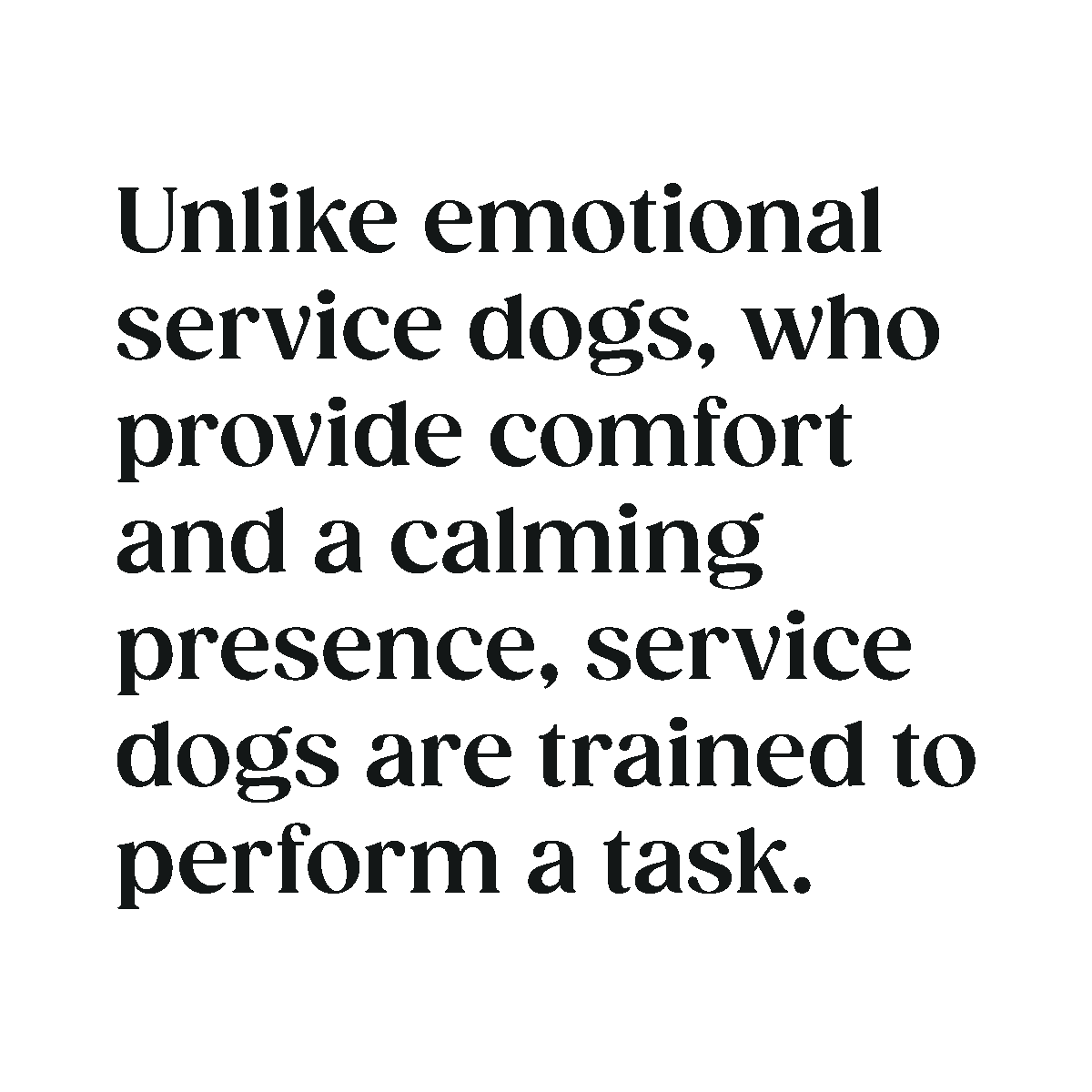
Unlike emotional service dogs, who provide comfort and a calming presence, service dogs are trained to perform a task. That task can include monitoring blood pressure for someone who struggles with diabetes, mobility assistance, alerting for seizures, assisting individuals with visual impairment, or psychiatric support for conditions like depression, anxiety, and PTSD.
Rocket, some 85 pounds of chocolate English Labrador, became a beloved member of the Jarrett family last July 15. It’s a busy household that includes parents Brianna and Fred, Ari’s two sisters, including his twin, a pit-mix rescue named Bingo from BARCS, plus two cats, two fish, and five chickens, who roam their Anne Arundel backyard. Rocket is a family dog like any other, but he’s also an incredibly competent canine who assists Ari in living as independent a life as possible.
Based on the recommendation of a friend, the Jarretts turned to Sweetwater Labradors, a breeder on the Eastern Shore’s Kent Island and chose him from a lively litter of puppies. To make sure he’d be the right fit for Ari’s needs, the Jarretts enlisted the help of Christy Dugan, who owns the Howard County-based Dog Training Elite of Central Maryland, one of the few outfits in the area that trains service dogs.
Any breed can be a service dog, says Dugan, but genetics plays a huge part. “Dogs were bred for specific purposes,” she says. “The breed does make a difference.”
Dugan assessed Rocket using temperament training, a kind of canine personality test that can predict what a puppy will be like as an adult. “For a service dog, we are looking for a dog that is social,” says Dugan. “One that wants to be with people. We are looking for a dog that will follow along. In this case, we are looking for a dog that will want to retrieve and is not afraid of loud noises.”
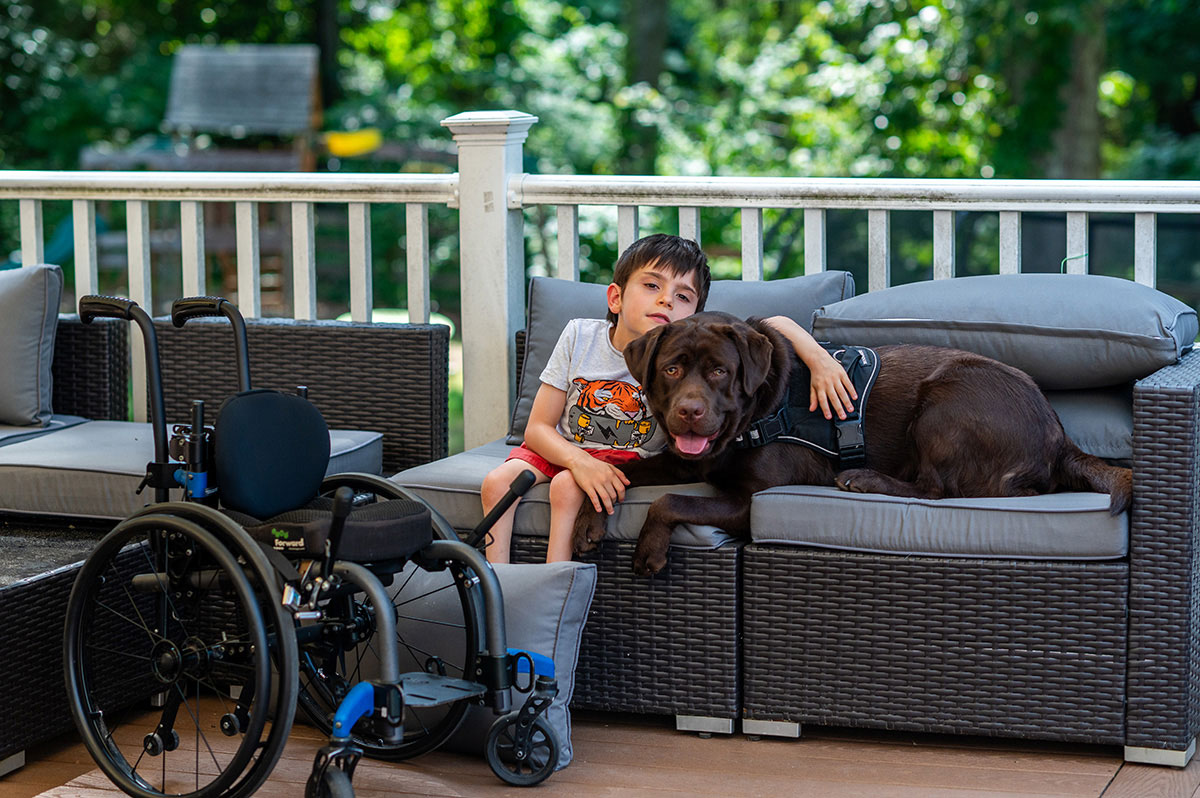

It’s often advantageous to acquire a service dog as a puppy so they can be properly trained in the most basic skills: potty training, crate training, and obedience. From there, the training moves on to visiting public places, whether that’s taking the animal on a bus or to a doctor’s office, so they learn to remain neutral to their environment while focusing on their handler.
“We expose them to as many situations and places as possible and to ignore all the distractions around them,” explains Dugan. “Once we get them comfortable with that, we start the task training, and it is these tasks that make them a service dog, training the dog to help with whatever their handler needs.”
Although Ari was first drawn to the “green dog,” he says (the one wearing a green collar), Dugan was convinced that it was the blue-collared Rocket—both energetic and easygoing—who was the right dog for the job of picking up objects that Ari dropped on the floor. “If he drops something, he can’t pick it up,” says Brianna. “And as an 8-year-old in school, they drop stuff constantly, so one of those things we wanted to do was get a service dog to help with mobility issues.”
Ari lists the various items Rocket routinely fetches for him: “pencils, pens, goggles, markers, my violin case.” Recently, says Brianna, Rocket pitched in without anyone asking and removed a stack of tortillas wrapped in a dish towel when she and Fred were cleaning the dinner table. “I put them away in the refrigerator,” says Brianna laughing. “They were still perfectly stacked.”
While Rocket is still considered a service-dog-in-training, it’s clear that he’s top dog. Back at the gym, Dugan’s husband, Sean, drops his wallet on the floor in front of Rocket to demonstrate his talents. Without missing a beat, Rocket picks the wallet up in his mouth and hands it back—even more amazing since the wallet is metal and dogs don’t like metal in their mouths.
Later, as Ari comes off the court for a snack, Rocket sleeps like a champ and remains completely unfazed as the chair comes perilously close to rolling over his nose and then his paw. Mind you, he might be asleep, but he’s still at Ari’s beck and call. Even in the chaos of the gym, with some 20 kids playing tag in wheelchairs and bouncing balls, one word from Ari is all it will take for him to run to his side. “He’s tired because it’s all brain work,” says Dugan of the snoring dog.
Training, as is the case with all service dogs, is ongoing. “It takes thousands of hours to train a service dog,” says Dugan. “It’s very intense and we like to start training with a dog as young as possible.”
Five days a week, Ari does 15-to-20-minute training sessions. “He sits in the chair and drops random things for Rocket to fetch, and we also use him as a conveyor belt,” says Brianna, who’s sitting on the sidelines. “I will call him and give him something to take to Ari.”
Of course there are various rewards, from pieces of chicken to cheese, but it’s clear that praise, petting, and love work just as well, as Rocket licks Brianna’s face, wags his tail when Ari pets his head, and puts his limbs on Fred’s shoulders and kisses him. “Service dogs like to get paid,” notes Dugan, “and this family pays him in full.”
In the months to come, the young dog will learn a few new tricks. “We are also getting ready to teach him bracing,” says Dugan, “so that Ari can use him as a backstop and can lean against Rocket.”
Beyond the tasks themselves, Rocket serves an even more important function: “Having Rocket has made Ari so much happier,” says Brianna.
As for Rocket, he seems to take pride in understanding the assignment. “He loves everyone,” says Brianna, “but he knows his job is Ari.”
RESOURCE GUIDE
EAT
Affogatto
This new disco-themed cat cafe in Fells Point features fancy caffeinated drinks—espresso topped with gelato and coffee-art lattes—alongside scratching pads, feline artwork, and water fountains for the kittens in residence, all of whom are up for adoption.
Blue Pit BBQ
The restaurant’s name is inspired by the owners’ own blue-nose pit bull. Dog-friendly features include a patio with water bowls and treats. The pulled pork leaves everyone begging for seconds.
Good Boy Bagels
The doggy décor at this charming Canton bagel shop beckons dog lovers and their four-legged patrons. Enjoy a bagel and schmear while your dog gets a treat and a bowl of water or get your order to-go (they’ll ask for your dog’s name and breed and deliver it curbside).
Ovenbird Bakery
Owner Keiller Kyle is a former bird biologist, but he’s a dog lover too, which is why this wonderful Highlandtown bakery has a pooch-friendly vibe and four-legged companions are welcomed.
Peabody Heights Brewery
This Abell brewery on the site of the Old Orioles Park allows leashed dogs on its grounds. Crack open a cold one while feeling the warmth of a cold nose.

Growing up with farm animals teaches life lessons.
By Christianna McCausland


n an overcast day last March, I found myself in line waiting on the season’s most sought-after commodity: chicks. Each spring, tractor supplies and feed stores fill with buckets of them, but this year, with soaring egg prices, these little balls of fluff are in high demand. A sign on the door said chicks would be available at 2:30 p.m. and no more than 20 per customer. As we waited, a guy started canvasing others, weighing his odds against the inevitable sellout. “How many are you getting? What breed?” Someone toward the end of the line got a call on his cell. “My wife says they just got a delivery of Rhode Island Reds at TSC—I’m out.” Several others followed him. It was like camping out for U2 tickets in the 1990s.
Thankfully, I was lucky number eight and came home with my four chicks—two each of Black Copper Marans and Olive Eggers—tucked into a cardboard Munchkins box. (Worth noting: They were twice the price of last year.)
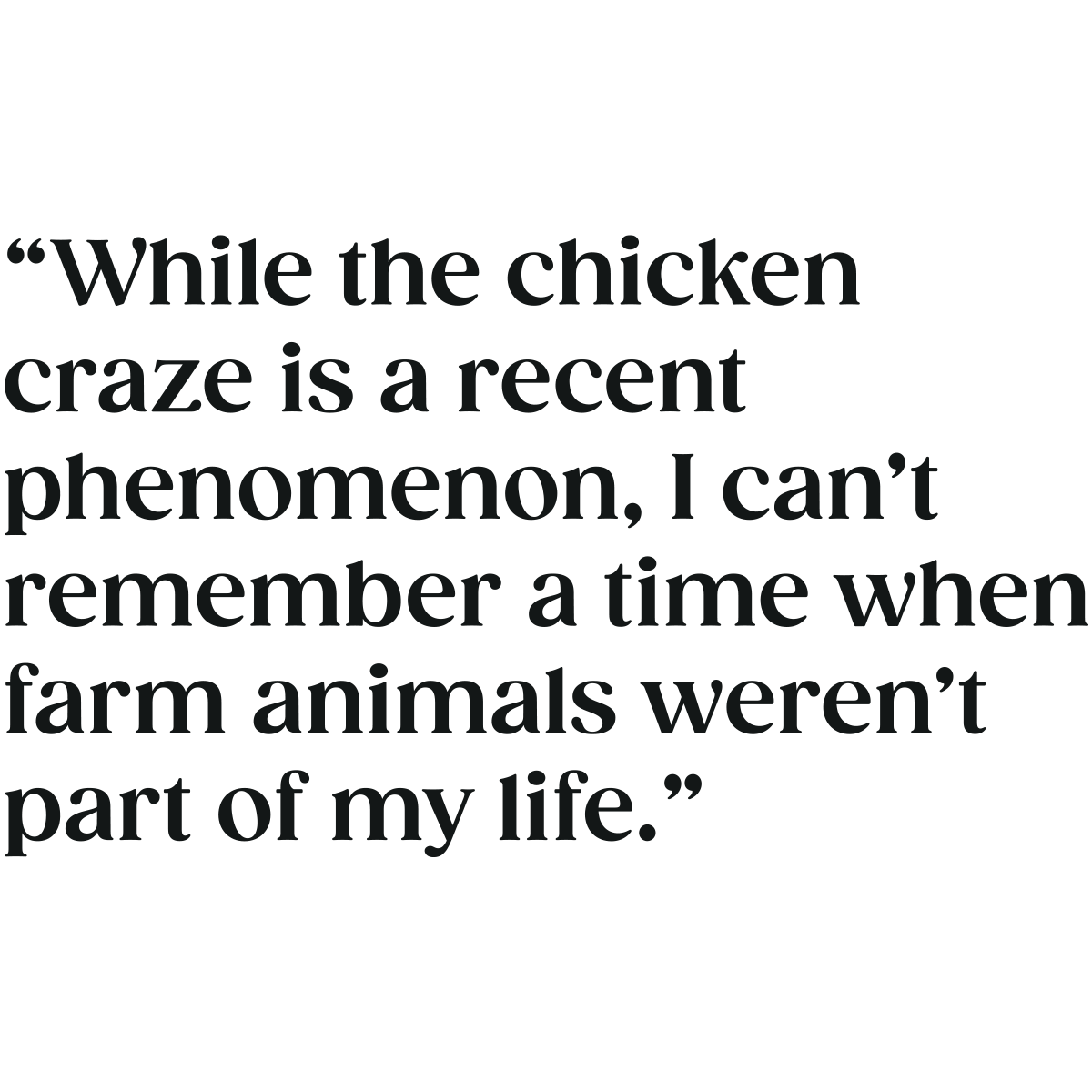
While the chicken craze is a recent phenomenon, I can’t remember a time when farm animals weren’t part of my life. We grew up with James Herriott on MPT in the kitchen and a menagerie of ponies, sheep, hens, cats, and more outside. My brother (now a veterinarian, shocker) was always bringing home wounded and abandoned animals as well as keeping his own zoo of exotics, including a gecko and a white rat named Templeton he trained to sit in the hood of his sweatshirt.
And so many rabbits. There was the bunny who moved to an outdoor hutch because it kept chewing electrical cords and an albino lop with an underbite that required special tooth trimming. And there always seemed to be a miniscule kitten needing to be fed with an eye dropper. My mother raised sheep and was particularly adept at resuscitating sick lambs with shots of glucose and time on a heating pad or, my favorite, by popping them into the oven on low with the door cracked open. She always raised the orphaned lambs, too. Each spring there’d be a dog kennel in the entry hall and a basket on the backseat of her station wagon where these little cotton ball cuties would reside, getting bottle fed every three hours. Every April I still crave the joyful company of lambs. (I follow a lot of shepherds on Instagram.)
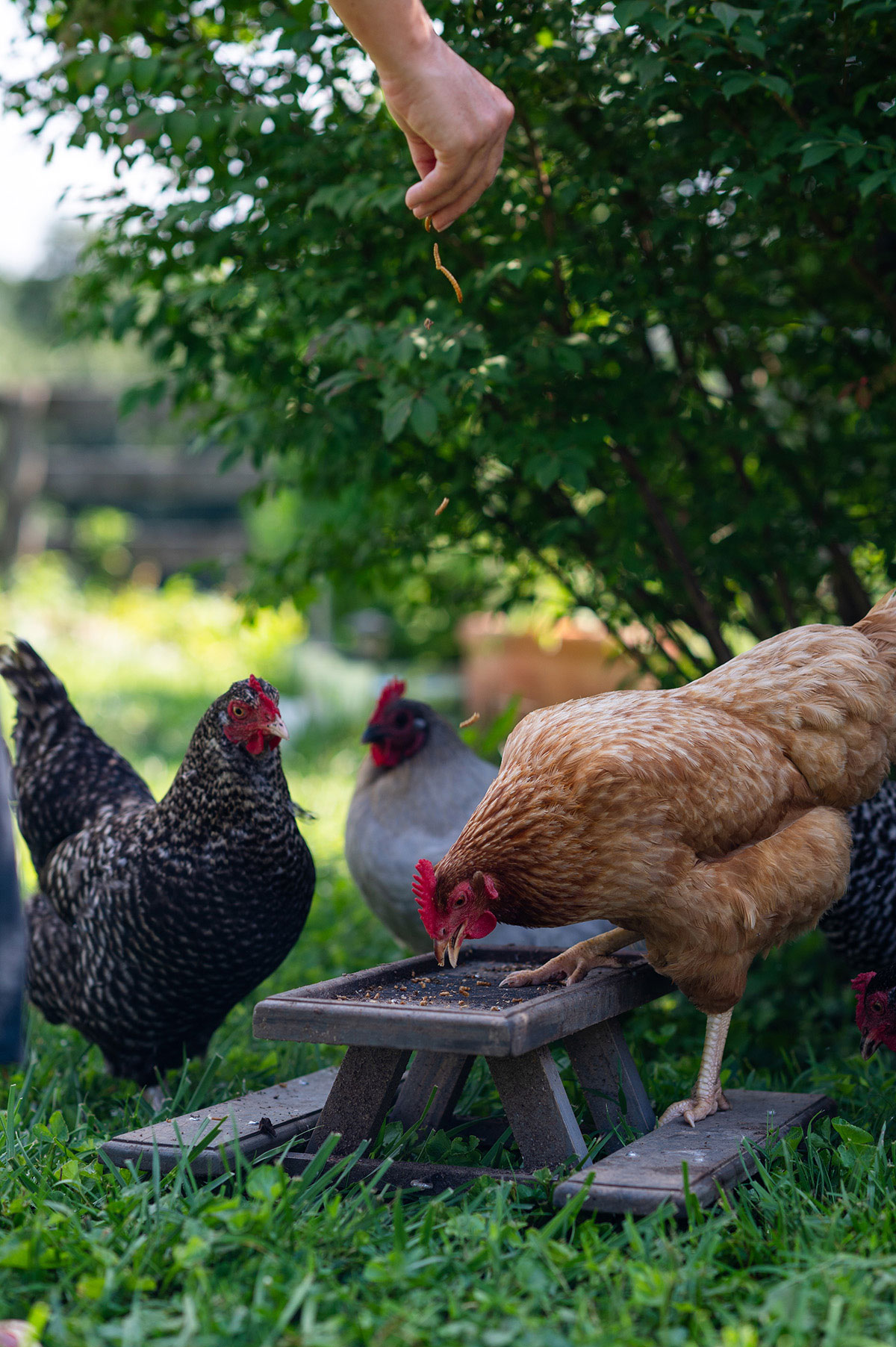

If it sounds idyllic, it kinda was. And it’s a life that was important for me to give to my own daughter. But not just because it is idyllic. Also, because it is hard. Farm animals teach you the toughest lessons. There were dogs that attacked our ewes and racoons that went on bloody rampages in the henhouse. Two years ago, I lost almost all my hens to a brazen fox, and we’ve had chicks hand-raised under a grow light in my office that failed to thrive and faded before our eyes. And inevitably, that lamb was going to end up in our oven as supper.
But without them, how do we learn not only where our food comes from, but how hard people work to get it there? How do we learn the physical and emotional gentleness to hand-feed an animal that may fit in the palm of your hand, as well as the fortitude to chase off a rogue dog with a shotgun? Sustainability, self-sufficiency, animal welfare, responsibility—it’s all there to be learned. There is no responsibility greater than to ensure the hens have adequate water during a heat wave or are shut in safely on a frigid night. Get it wrong and their death is on your hands. It’s why I don’t name our hens—their lives can be fleeting. But death, too, is a lesson.
We have a precious dog and an imperious feline in our household, but it is the chickens who remind us that life is both brutal and beautiful.
RESOURCE GUIDE Continued
PLAY
Cylburn Arboretum
Set on 200 acres, this serene spot in Mt. Washington offers dog-friendly hiking trails, specimen trees, gardens, and a greenhouse. If you enjoy geeking out over nature, bring your binoculars to get a proper close-up of the wildlife.
Lake Roland
There are plenty of wetlands and woodlands to go around in this waterfront park with miles of pastoral paths. If you want a designated, fenced-in park, there’s also the lakeside, members-only Paw Point Dog Park for Fido to fraternize off-leash.
Oregon Ridge Park
Enjoy more than 1,000 miles of glorious nature and hiking trails for frolicking or frisbeethrowing at this Cockeysville treasure. There are also picnic tables and streams for splash sessions if you or your pet need to cool off.
Patterson Park
Our town’s answer to Central Park has countless paths for dog-walking and peoplewatching. There’s also a dog park within the park—plus benches, a water fountain, and turf—if you need to give your greyhound a little exercise off leash.
Quiet Waters Dog Park
Bordering the South River and Harkness Creek, this dog park in Annapolis offers some of the prettiest vistas around. There are off-leash areas for your canine and swimming, digging, and chasing opportunities abound as well as a rinsing station for good, clean fun.

Sometimes dogs make the best dining companions.
By Amy Scattergood
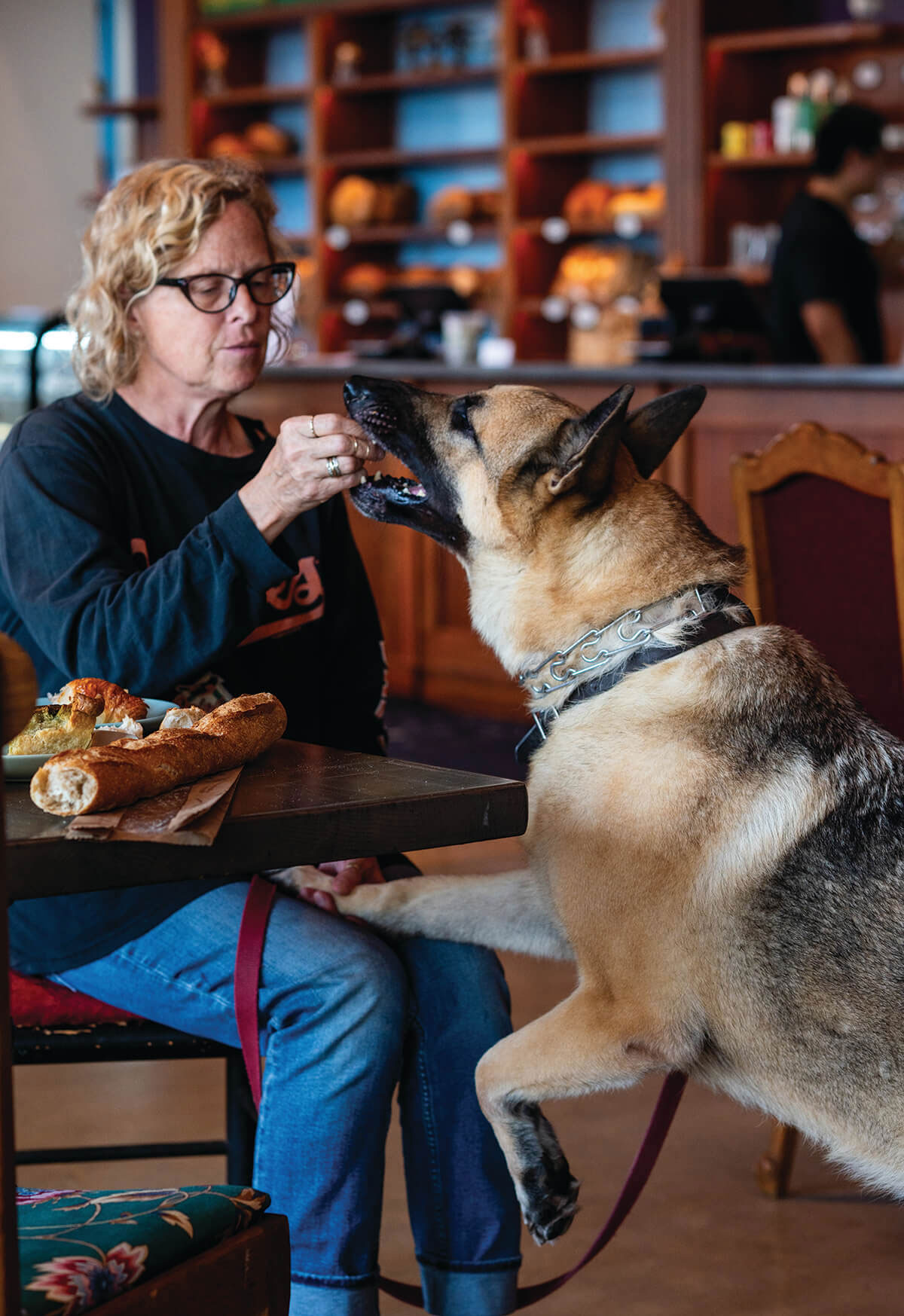

hen I adopted Angus, six brutal weeks after the death of my previous dog, he wasn’t malnourished, but he was about 20 pounds underweight. An 18-month-old German shepherd from Phoenix Animal Rescue, a terrific shelter in southern Pennsylvania with a fondness for Malinois and German, Dutch, and Belgian shepherds, Angus is my sixth German shepherd and third rescue. Sixth consecutive shepherd, I should say, as I do not—yet—live in the backwoods of northern Canada, otherwise I’d undoubtedly have a whole pack of them. Two and a half years later, Angus weighs in at a sturdy 110 pounds. This is because he has become not only my life companion, but my dining companion.
As I write about food for this magazine, I come home with a lot of leftovers, many of which find their way into Angus’ bowl. When I wrote a feature about Baltimore diners, while I breakfasted with my late father, I’d often order take-out for my dog—side orders of the scrapple my father loved, that I do not love, but that Angus enjoys as much as my dad did.
And when my dad and I would visit the restaurants I was reviewing, he’d often contemplate the menu, then say, “What would Angus like?” For the record, Angus loves oxtails and meatballs, unsurprisingly, but is also fond of ramen, dumplings, tacos, and tofu. As I can’t take him into restaurants—except for Ovenbird Bakery in Highlandtown, pictured below, which we visit regularly—he mostly gets take-out except when we’re on our daily walks around the city.
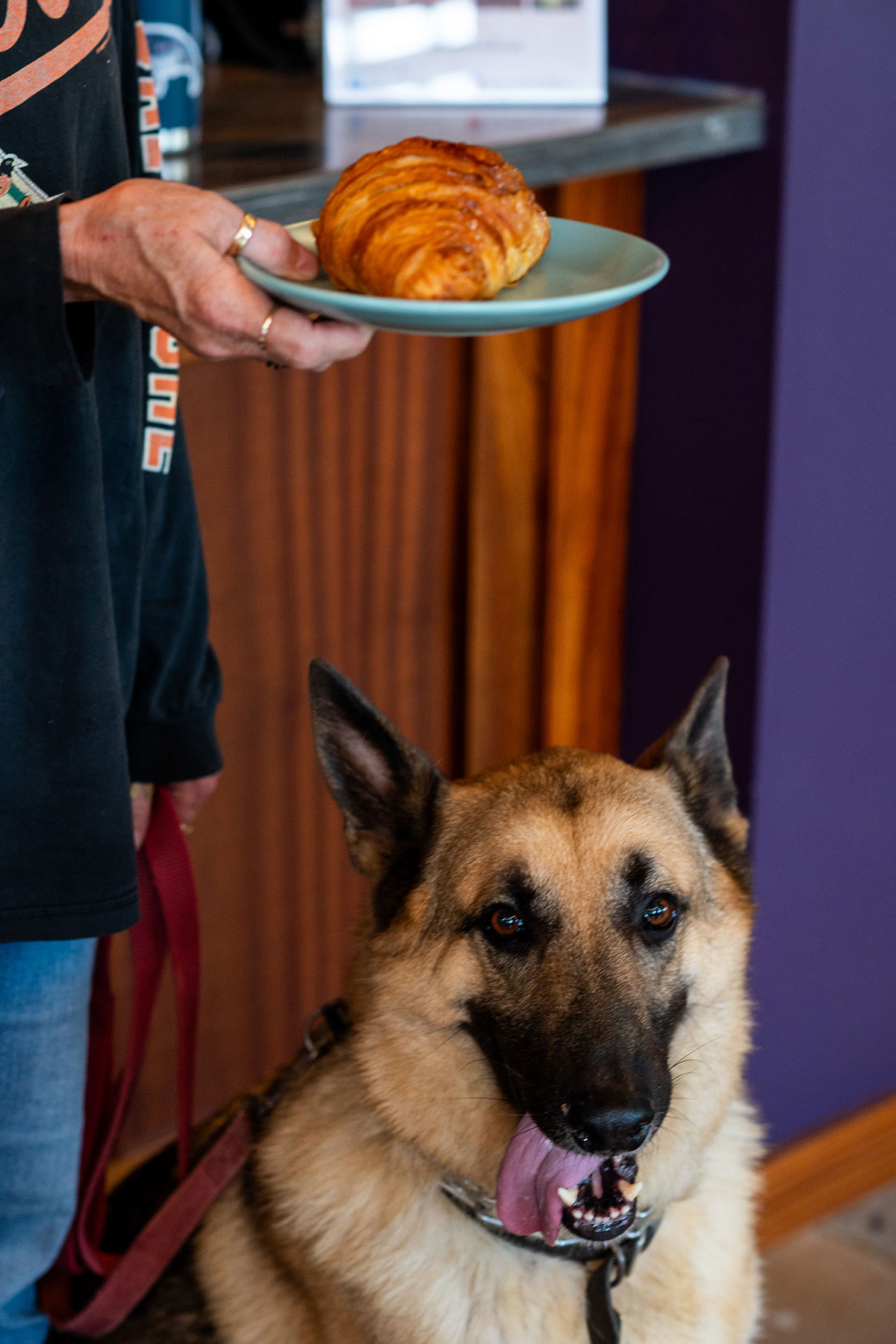
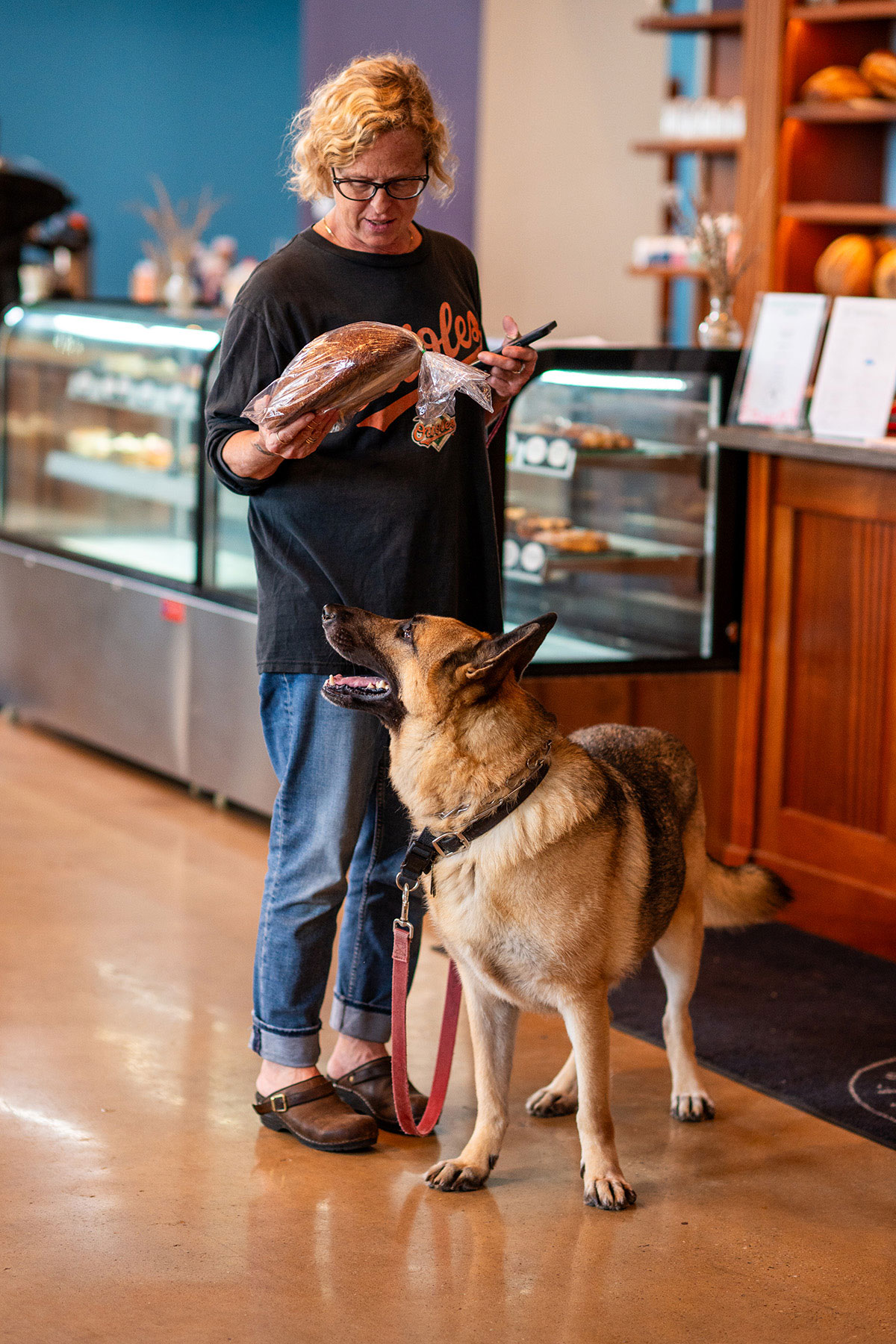
These take us to Fells Point, en route to the Inner Harbor and the Sagamore Pendry hotel, where there is a large basket of dog biscuits at the concierge stand. Across the cobblestones, the Daily Grind has a walk-up window for dog-walkers, through which they’ll hand over a square of cheese with your cortado. There’s also Fuzzie’s food truck, recently permanently installed a few doors down on Thames Street, which, bless them, has a special bunless smashburger for dogs on its menu. And then there’s the Royal Farms on Fleet Street, where I had my first order of the justly famous fried chicken when we stopped for a snack one day after a long walk around the harbor.
Angus has had many chicken dinners, in the form of leftovers from Bunny’s Buckets & Bubbles, Peruvian chicken from Highlandtown, and the splendid rotisserie birds from Chachi’s and the now-closed Nana, but his favorite to-date has been from the bag of RoFo we got on the way home.
He is a Baltimore dog, after all.
RESOURCE GUIDE Continued
SHOP
Book Hounds
This bookstore in St. Michael’s takes its name seriously. Dogs are welcomed with a free biscuit and lots of soft surfaces, from hot-pink dog beds to Chesterfield sofas. Of course, there are water bowls and snacks to spare.
Clipper’s Canine Café
This Ellicott City shop is a natural pet food store and boutique featuring a “raw bar” of Naugahyde bones, stylish collars and leashes, as well as shampoos to transform your dog from stinky to sweet. Consider buying a Canine Care Pack for service dogs who go to veterans.
Howl
Long before it was trendy to feed your pet like you feed yourself, this 22-year-old mainstay was focused on high-quality, ethically sourced food and gear (dental chews, shedding combs) for cats, dogs, and small animals. They carry hard-to-find brands and deliver those heavy bags of kibble to your front door.
Scratch & Sniff Pet Supplies
This all-natural pet supply store in Jacksonville has a knowledgeable staff, a friendly vibe, and a highquality selection of pet supplies for the dog, cat, gerbil, or bird in your life. They also offer nutritional counseling and DIY washing stations.
Sea Dog Pet Boutique
This family-owned shop sells anything your animal needs, from toys to treats. Much of it is Maryland-themed, like the crab-shaped toys and bow ties and Ravens bandanas.

After my beloved Oscar died, could I love again?
By Max Weiss


am firm believer that dog people should have dogs. This belief has gotten me through the death of my quintessential mutt Maggie (“What breed is she?” I innocently asked the vet. “All of them,” he replied) and the needy, clingy, soulful Harriet, who followed. But when Oscar died, I wasn’t sure I could do it again.
I’d raised him since he was a pup, just a slippery, squirmy little guy who had two modes: extreme chaos and sound sleep. Eventually, he calmed down (a bit) and his true personality shined: silly, neurotic (he had random fears like thresholds and windy staircases), cuddly, and loyal. I live alone, so it’s not a lie to say that Oscar got me through COVID—he was a four-legged lifeline.
So, when Oscar died at the age of 15, I wasn’t sure I could do it again. His death hit me hard—I wailed so loudly I feared the neighbors would call the police.
But dog people have dogs.
Six months after Oscar died, I dipped my toe into the adoption pool again. The Instagram algorithm already knew my type—scruffy and small.
My feed was filled with doe-eyed, pert-eared terrier mixes, along with various descriptions of their personalities: high energy, fearful, not recommended for families with small children, etc.
I saw Gus—then named Chocolate Chip—on PetFinders.com. He was 14 pounds, black and brown, with fur that was alternately scruffy and fluffy (scluffy?). I thought he looked a bit like Toto from The Wizard of Oz.
He had been abandoned in a construction site in Austin, Texas, along with two other dogs. One of the dogs got hit by a car and died. The other two, Gus and a blond terrier type named Rosemary, got scooped up by local shelters.


I applied for Gus like I was applying for a high-stakes job. The shelter, Dizzy Dog, wanted to make sure I wouldn’t return him. “What behavior would you find unacceptable in a dog?” they asked. “Smoking?” I cracked. They did a virtual tour of my home, confirmed I had a gated backyard, and there was an extended phone call where I learned the “3-3-3” rule of what to expect when your dog first arrives: Three days of fear and uncertainty; three weeks of settling in; three months when they realize they’re here to stay and begin to show their true personality.
Then I did a Zoom call with Gus’ foster mom, Amanda. (Gus sat in the back of the frame munching on a bone, as if protesting the very concept of a virtual meet-and-greet with a dog.) My adoption application was approved and it was time to ship Gus halfway across the country to come home.
I was told to meet the transport truck at the White Marsh Royal Farms.
“Sounds sketchy,” I told the adoption agency. “It’s for easy access on and off the highway.” I arrived early, as is my wont, and wasn’t sure I was in the right place until I saw other hopefuls emerge from their cars with leashes and squeaky toys.
Finally, the truck, neatly stacked with dog crates, pulled up and Gus was the first to come out.

I had given myself a pep talk not to take it personally if he was scared, didn’t take to me right away, hid in his crate, or even if he snapped at me.
He’s been traumatized, I reminded myself. He needs time.
Instead, he melted into my arms. When I put him down on the grass, he promptly pooped. An angel and a genius! I could lie and say there was a long adjustment period, that the 3-3-3 rule was a handy guide, but that just wasn’t the case.
Gus was sweet and loving and well-behaved from day one.
I was told that I shouldn’t have him sleep in the bed with me for the first week or so—to allow him to establish his crate as his own safe space.
The first night, I dutifully dragged Gus’ crate to my bedroom, put him inside, and turned out the light.
He began to whimper.
The great “Don’t Let Gus Sleep in the Bed With You” experiment lasted for all of two minutes. He’s been sleeping with me ever since.
Six months into our relationship, Gus is just the best little guy, my ride-or-die. I talk to him about Oscar sometimes. They would’ve liked each other.
A post script: Remember Rosemary, the dog who Gus was found with? Well, she stayed in the family. A month after I adopted Gus, my sister, Felicia, who had lost her adorable poodle-mix Ruby just a few weeks before Oscar died, adopted Rosemary, now named Gertie. Who doesn’t love a happy ending?
ON THE COVER

J.B. Shepard’s pet portraits bring out the personality in each of the subjects he shoots.
By Jane Marion



—Costume Design and Styling by J.B. Shepard/The Puptrait Studio
Local photographer J.B. Shepard didn’t set out to become a pet portraitist. For years, Shepard was shooting what he says were “edgy, darker” portraits of people. But when a friend who had a Great Dane who was dying of cancer wanted a final photograph of her beloved Thunder Bear before he died, she commissioned a portrait.
“She told me that everyone was doing these girly, flowery things with dogs,” he recalls. “It just wasn’t her vibe, so she asked me to photograph Thunder Bear.”
The result was a haunting image of an all-black, sinewy dog sitting on a bright yellow sofa in silhouette. The tumor is visible on the dog’s forepaw as it dangles off the sofa.
Years later, it’s one of the many provocative images in the award-winning artist’s Woodberry studio. After that one gig led to many jobs, the lifelong dog lover started his photography business, Puptrait, in 2015.
Through the years, Shepard’s signature style has evolved into putting some sort of costume on the canines, which he says adds to the energy and helps capture the essence of each dog. The costumes themselves, usually a hat or a so-called “ruff” collar (meant to mimic an Elizabethan-style collar), are handmade and crafted from found and recycled materials, including junk mail, newspapers, and cardboard boxes.
“Usually when you’re talking to a dog, they are listening to your commands or waiting there for you to give them a treat, and you end up with these expressions that are very removed,” notes Shepard. “One of the great things about these costumes is that we pull them out of that mindset—it gives them something to interact with that isn’t us.”
Do some of the dogs object to the costumes? Of course. But Shepard says he can often capture the pup in that split second the hat or collar is secured—and he never forces the issue.
From Chihuahuas to Labs, he’ll shoot any breed, though Staffordshires and pit bulls are favorites. “They’re just so durable and have people-sized heads,” he says, “so you can just take a hat and some glasses and put it on there and it stays.”
While the artist is passionate about his work, the one downside is dealing with subjects that are so ephemeral.
“The one thing that never gets any easier is that all the dogs are eventually gone,” says Shepard, “but you know that’s part of the gig.”

The legacy of these pop culture pets live on.

BENJAMIN “BEN” MOORE
Ace Hardware
Ben was a greeter and mouser at Ace in Waverly for 14 years. The late feline was given a retirement party in 2023. Hundreds attended.

SNAKES
Dr. Howard Kelly
A founding physician at The Johns Hopkins Hospital, the gynecologist was also an expert on exotic snakes, which he kept in his home library.

FRANK
H.L. Mencken
Menken kept a pony outside his Hollins Street home. The Shetland once put his head through an open window to eat ice cream left on a sill.
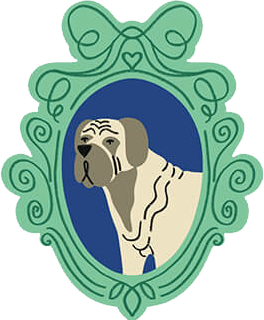
FRANK
Frederick Douglass
Douglass had a bullmastiff named Frank. The dog allegedly died of grief a few weeks after the abolitionist’s death on Feb. 20, 1895.

CATTARINA
Edgar Allan Poe
“The Black Cat” writer had a tortoiseshell cat who sat on his shoulders when he wrote. She lived with him from 1844 until his death in 1849.
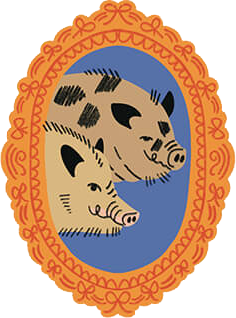
OLLI AND FERNIE
Jesse Sandlin
These Juliana pigs share an East Baltimore rowhome with chef Jesse Sandlin. They have their own bedroom on the second floor.
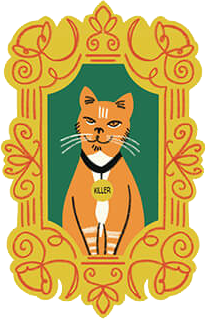
KILLER CAT
Hampden
This tabby who prowled Hampden’s Avenue had his own Instagram account and raised money for BARC’s animal shelter. He is immortalized on a saltbox.
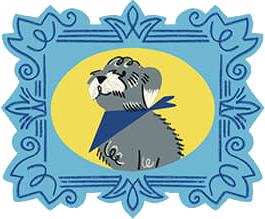
TUCKER BALTIMOORE
Wes Moore
The Maryland governor has an adorable gray rescue shih-poo who can be seen playing, peeing, and fetching at Government House in Annapolis.

HERMAN
Port of Baltimore
As an expert mouser, this gray cat was a favorite feline at the Port of Baltimore. He held a U.S. Coast Guard ID in 1943, with a pawprint in place of a fingerprint.

